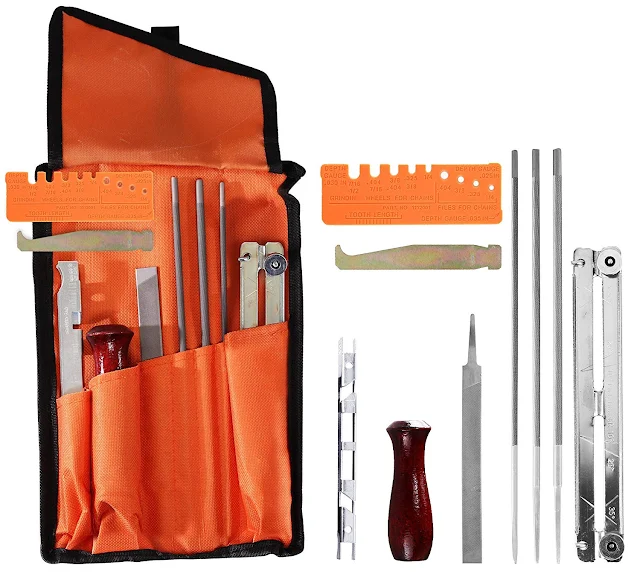⛓️The Ultimate Guide to Properly Sharpening a Chainsaw
Have you ever tried to carve a leg of lamb with a blunt knife or shave with a dull razor? It's a frustrating and ineffective experience.
The same is true for using a chainsaw with a blunt chain.
At best, the job takes longer and is much harder work. A dull chain can also cause unnecessary wear and damage to your bar. At worst, a blunt chain can get stuck in the wood or glance off, creating a dangerous situation.
If you have a job to get done, you need a sharp machine.
The maintenance of your chainsaw is crucial, and a key part of that is knowing how to properly sharpen your chain. It's a relatively simple task, but you have to apply the principles correctly.
The goal is to sharpen each cutting tooth as evenly as possible for a smooth, efficient, and safe cut.
The Science of a Sharp Chain
A chainsaw chain doesn't just cut; it chisels. Each cutter tooth has two key parts: the cutting edge and the depth gauge (or "raker").
The cutting edge slices the wood fibers, and the depth gauge controls how deep that cut is. When a chain is sharp and the depth gauges are set correctly, the saw pulls itself into the wood, efficiently removing material in coarse chips.
A dull chain, however, scrapes instead of cuts, producing fine sawdust and requiring you to force the saw through the wood. This not only strains the engine but also dramatically increases the risk of a dangerous kickback.
❓When Do I Need to Sharpen My Chain?
Your saw will give you clear signals when it's time for a sharpening. Look out for these signs:
- The chain does not pull itself into the cut. You have to force it by applying downward pressure.
- You're getting fine sawdust instead of coarse wood chips. Remember, you want crunchy sawdust, not dust!
- The cut produces smoke, even though the chain is properly lubricated and tensioned. This is a sign of excess friction from a dull chain.
- The cut wanders in one direction. This indicates that the cutters on one side of the chain are duller than the other.
- The chainsaw "chatters" or "bounces" during the cut. This often means your depth gauges need to be checked and adjusted.
🛠️The Tools You'll Need for the Job
You have two options for sharpening: a quick touch-up with a file or doing the job properly with a full kit. We recommend the latter. You will want to have on hand:
- A pair of safety gloves.
- Protective eyewear.
- A clamp or vice to hold the chainsaw securely in place.
- A chainsaw sharpening kit, which should include the correct sized round file, a file guide, and a depth gauge tool.
You can find all the tools you need in these handy kits on Amazon.
✅How to Safely Sharpen Your Chain: A Step-by-Step Guide
- Safety First: Turn your chainsaw off and disconnect the spark plug cap to prevent any accidental starts.
- Tension the Chain: If you are sharpening the chain while it's still on the bar, make sure it’s tensioned properly. It's hard to sharpen a loose chain.
- Gear Up: Put on your gloves and safety glasses.
- Clean the Chain: Clean any oil and grease off the chain. This prevents your file from getting gummed up.
- Inspect for Damage: Check for any broken cutters, bent drive links, or loose rivets. If your chain is too worn or damaged, replace it with a quality new chain.
- Begin Sharpening: Place your file guide on the chain. Using firm, even strokes, push the file forwards across the cutter. Only file in one direction; lift the file off the chain on the backstroke. After two or three strokes, check your progress.
- Be Consistent: Use the same number of strokes on each cutter to ensure they are all the same length. The file guide will help you maintain a consistent angle.
Here's a great video tutorial from the team at Bunnings Warehouse in New Zealand:
Can I use a 'rotary tool' to sharpen a chainsaw?
You sure can, if the attachment is the right size for the chain. A great example of this kind of tool is the Dremel 100-LG Lawn and Garden Rotary Tool Kit. It comes with sharpening attachments designed for lawn mower blades, shears, and chainsaws, and it runs at 35,000 RPM for quick work.


